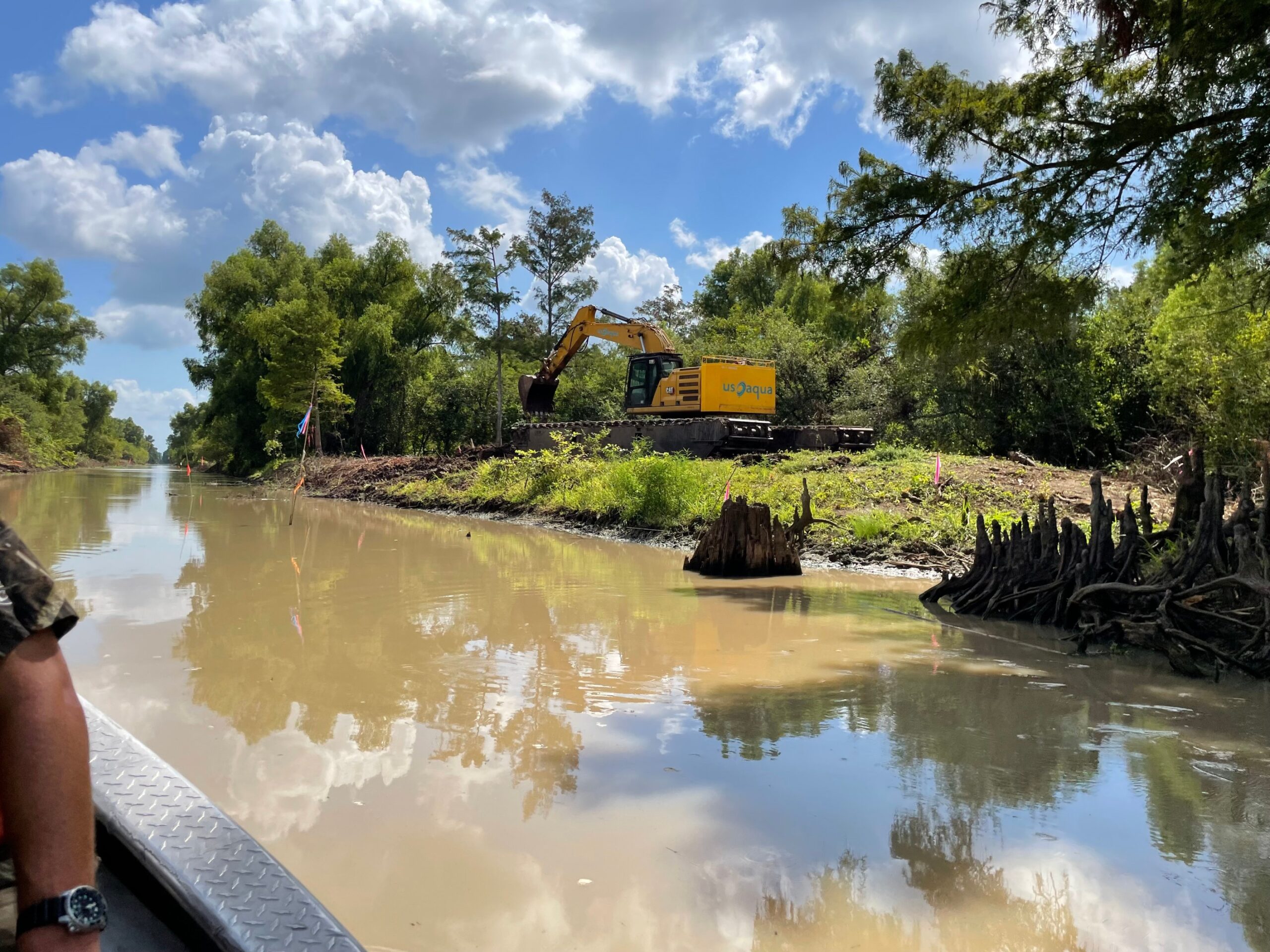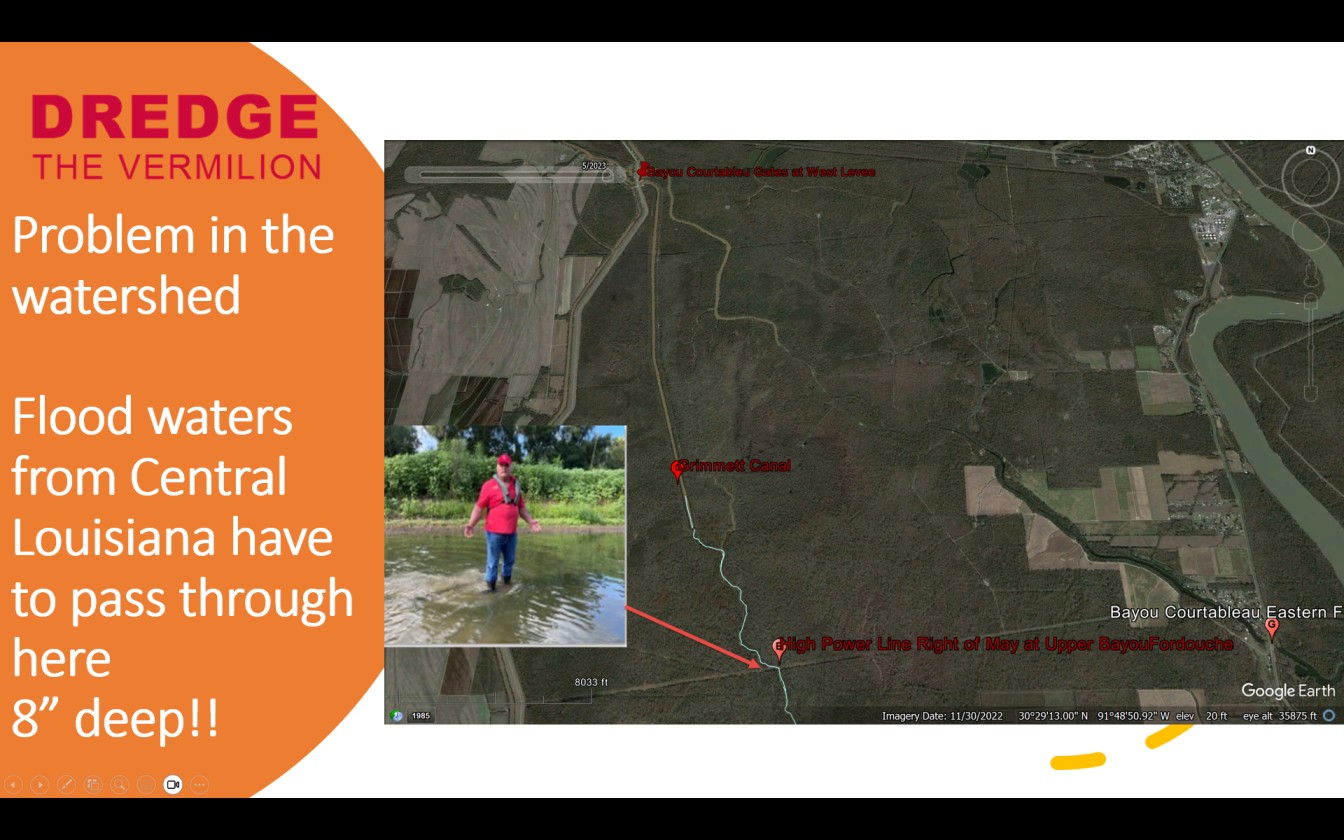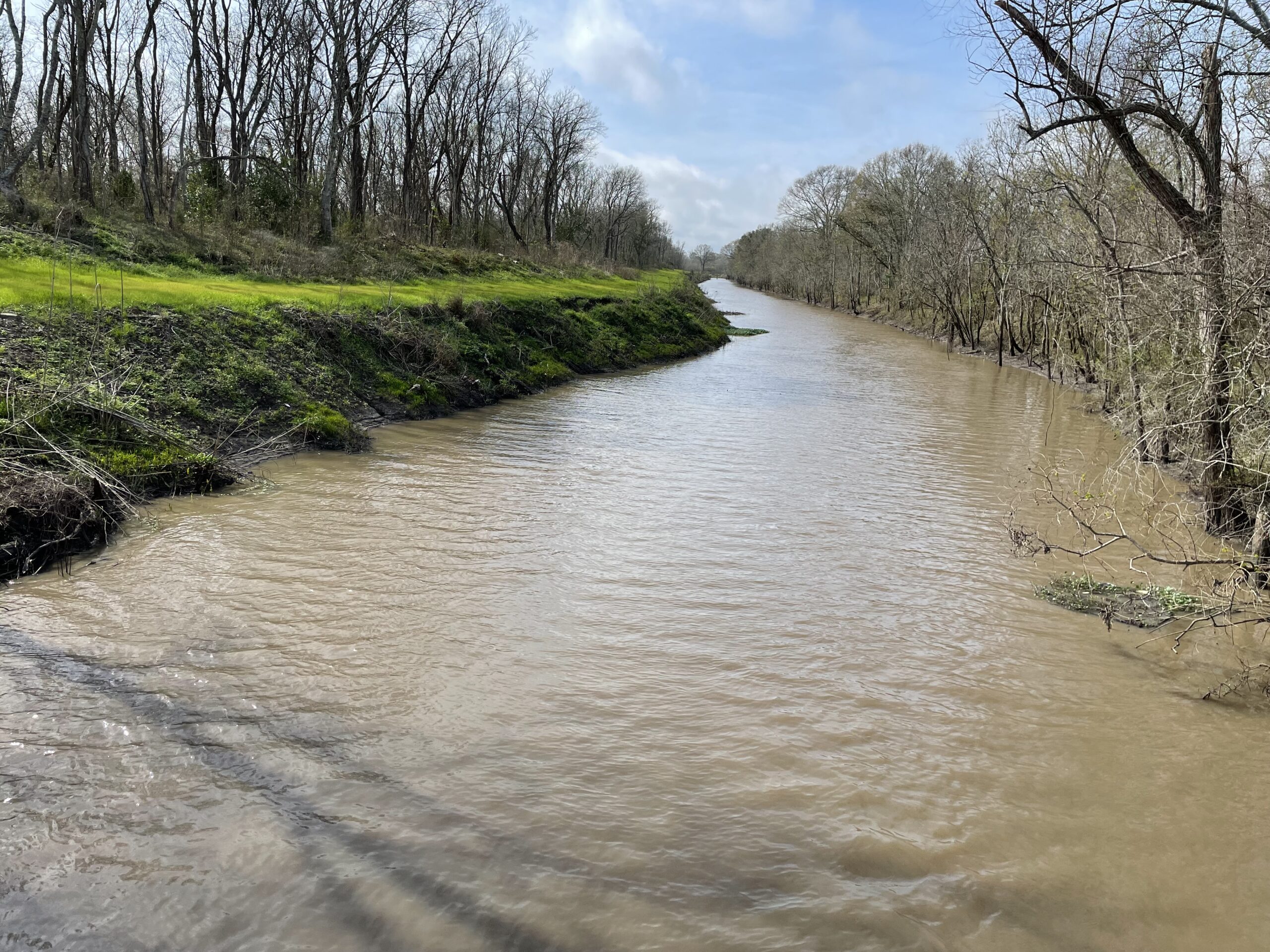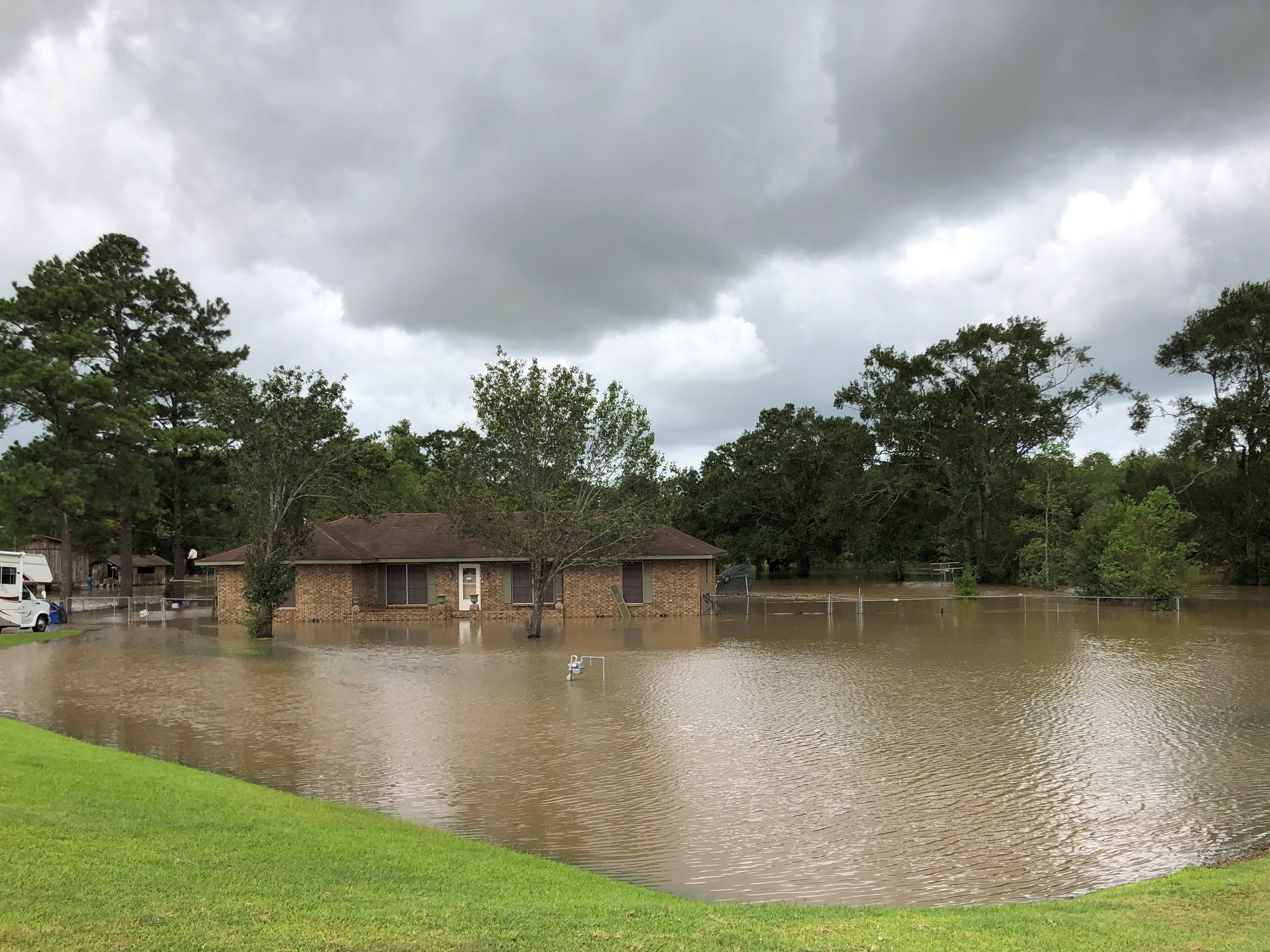Executive Summary
Over 7 years after the great flood of 2016 a number of flood mitigation projects have been completed or identified in our watershed. Two spoil bank projects that were severely needed have been completed. Some retention ponds have been completed or are in progress. Some of these ponds are in response to address flooding along the Coulee Ill des Cannes(CIDC) and the Vermilion River where flood mitigation projects are severely needed. Concerning the issue of clearing, snagging, and dredging, both St Martin and Lafayette Parishes have made some limited progress. You can read about these dredging projects in detail below.
Much more needs to be done. Many projects are in the que, most awaiting approval and funding, by the Louisiana Watershed Initiative(LWI) which unfortunately is mired in controversy about diversion of monies to a new District 9 (our watershed is District 5) which would utilize project money designated to other areas of the state including parishes in our Teche-Vermilion watershed. You can read more about this issue by clicking here.
Concerning time to complete flood mitigation project, we experienced several additional 100 Year Flood Events after 2016. We have been blessed during the last 2 years with a drought that allowed significant progress on projects that were funded in both Lafayette and St Martin Parishes. Unfortunately, little has been done in other parishes in the watershed as of today. However, a number of projects are waiting for funding from LWI which may never come. DTV intends to press forward in identifying potential projects and getting them funded, engineered, and finally completed.
The Great Flood of 2016
The great flood of 2016 was a devastating blow to our watershed and Lafayette community. Over 10,000 homes flooded along with many businesses and farms. Hundreds of millions of dollars’ worth of damage and lost GDP that probably totaled $500,000,000 or more for our Teche-Vermilion watershed.
The Robideaux Administration
Locally there was an outcry from the public to “do something”. Locally our Lafayette Parish Government (LCG), at that time, headed by MP Joel Robideaux, in their haste did projects in the wrong order by cleaning ditches and coulees that accelerated moving flood waters to the Vermilion River making the risk even greater in certain areas. In other words, an attempt to fix the problem was made before having a clear understanding of the problem. The founders of Dredge the Vermilion (DTV) made numerous efforts to share data and analysis with the Robideaux Administration but were unsuccessful in our efforts in arranging any meetings with the administration. Other parishes in the watershed did in fact meet with us on numerous occasions. A public hearing was held in conjunction with the Acadiana Sierra Club was held in 2019. This event was attended by a number of parish presidents, officials from the state, Representative Higgins office, the USACE and over 200 concerned citizens. Notably absent were any representatives of the LCG administration, however 2 members of the City-Parish council did attend. Their lack of interest in our findings may have been because the LCG Public Works Director was professing publicly that to really fix our flooding problems would take over $2B and getting this amount of funding would be impossible.
Dredge the Vermilion
Shortly after the flood a group of private citizens formed Dredge the Vermilion in an attempt to formalize the process of identifying the sources of the problems on a watershed wide basis. Additionally, we made project recommendations that we felt needed consideration, vetting, and engineering. As part of our efforts, we completed an analysis of US Geological Survey (USGS) and US Army Corps of Engineers (USACE) gage data that showed the risks had been increasing for many years and had reached a critical level by the 2016 flood event. When presenting this data that illustrated an increasing threat none of the public officials appeared to be aware this was happening, some even challenged our data. DTV continues our efforts to do analysis and recommendations to this day. This analysis during field trips pointed to a severe lack of maintenance of our waterways and existing drainage systems and underutilization of our natural overflow low lying swamps ability to receive flood waters.
The Guillory Administration
When the new LCG administration took office DTV met with them on numerous occasions to share our analysis and recommendations. Locally this included priorities of addressing issues with CIDC, the evaluation the removal of spoil banks in St Martin Parish as well as dredging the Vermilion River.
Additionally, regionally we identified drainage problems in the northern and central areas in our watershed that increased flooding risks on the southern parishes in the watershed including St. Martin, Lafayette, Iberia, and Vermilion. Our recommendations for this regional area of the watershed included removal of spoil banks in the West Atchafalaya Floodway, clearing and snagging certain channels, and flood water diversion into our natural overflow swamp areas like Henderson Lake and the Spring Bayou swamp in Avoyelles Parish. Additionally, we recommended formalizing flood mitigation operational procedures that involved Teche-Vermilion Freshwater District (TVFD), the USACE, the RRABB Levee Board in Alexandria, and St Martin Parish. As DTV met with LCG numerous times we also met with other parishes in the watershed and others involved in flood management like the USACE and the RRABB Levee Board and TVFD to share findings and recommendations.
Spoil Bank Projects
DTV identified 2 major spoil bank issues that impacted regional drainage. Both issues negatively impacted flood flows into natural overflow swamps.
Enterprise Dixie Pipeline Spoil Banks
The Enterprise Dixie Pipeline Spoil Banks (link) blocked regional flood flows to the Henderson Lake area which put great pressure on the lower watershed including Lafayette, St Martin, Vermilion, and Iberia Parishes and caused backwater flooding in Rapides, Avoyelles, Evangeline, and St Landry Parishes. This situation was caused by lack of adequate maintenance of the pipeline right of way as well as the fact that the USACE failed to ensure the pipeline backfilled the pipeline canal which was required by the permit. DTV assisted St Martin and St Landry in developing a conceptual project plan, securing funding, and clearing regulatory hurdles in getting a permit. The State Coastal Restoration Authority (CPRA) completed the project in August 2023.
Cypress Island Spoil Banks
After the Vermilion River Flood of 1993 in Alternative 1 of a report by the USACE evaluated modifying the Vermilion River by removal of these spoil banks. This option was identified by the USACE as a restriction to flood flows. This situation was caused by the unintended consequence of the USACE placing the spoil on the south bank of the river during the early 1950’s dredging project which blocked flood flows from entering the lowest and largest area of this overflow swamp. DTV did an independent analysis of data and concurred the validity of completion of a project to either remove or lower the spoil bank to the natural elevation of the riverbank. DTV developed a project plan that LCG adopted and ultimately submitted to the Louisiana Watershed Initiative (LWI) for funding in their Round 1 project group. DTV made numerous presentations regarding the benefits of the proposed project to parishes including Lafayette and St Martin as well as other organizations who had an interest in the Cypress Island swamp like the Nature Conservancy. In our communication efforts with residents of the Cypress Island community we noted extreme political opposition regarding the project and not allowed to present the project. LCG completed the project.
DTV’s Position on Spoil Banks
DTV believes that removal of spoil banks that restrict flood water flows is critical to reduce flooding by blocking drainage or flood flows to overflow swamps. Spoil, if left after dredging or canal construction, must be left with adequate gaps to allow flood flows without restriction and should be monitored if these gaps are plugged by debris, silting, and plant growth such as trees and bushes.

Enterprise Dixie Pipeline Spoil Banks
Retention Ponds Projects
In addressing the issues with CIDC LCG is in the process of completion of a series of retention ponds. This includes a number of large ponds between Ridge and Duhon roads and west of West Broussard Road. These ponds are complete except for the outfall which is waiting on correspondence from the USACE regarding permits. Additionally, the much-discussed Homewood ponds are under construction on the east side of the Vermilion at the confluence of CDIC and the river. As DTV understood in communications with LCG these locations were selected based on a number of factors such availability of large enough tracks of land and access to coulees or their laterals that drained to the river so water could be intercepted and stored in the ponds to be released when flood levels receded. The pond’s locations and sizes were selected by engineering models using a 100-year flood event which is standard practice in the engineering community.
DTV’s Position on Retention Ponds
Retention ponds are “standard practice” in the engineering community to reduce flooding in urban areas. However, these ponds are very expensive, and we recommended that they be utilized as a” last resort”. First, we need to formalize efforts to coordinate flood mitigation activities in the face of an imminent flood threat happens, evaluate, and perform main tributaries drainage maintenance (aka dredging), and utilize our natural overflow swamps to their maximum potential. DTV believes the project engineer’s design and models for the ponds need a chance to prove their effectiveness during a 100-Year Flood Event which is their design criteria then judgement can be made concerning their effectiveness.
Clearing, Snagging, and Dredging Projects
The Teche-Vermilion Watershed has a number of major drainage tributaries including the Vermilion River, the Red and Atchafalaya Rivers, the Bayous Boeuf, Cocodrie, Courtableau, Teche, and Bayou Amy and the Grimmett and Charleton Canals. All of these major drainage tributaries carry flood water south out of the watershed into the Gulf of Mexico or to the Atchafalaya River. Much has been documented and written about the need to do basic maintenance including clearing, snagging, and dredging on some of these major tributaries to ensure their ability to carry flood flows. You can read about more of these recommendations by clicking here .
DTV’s Position on Clearing, Snagging, and Dredging Projects

Grimmett Canal Outfall Flood waters from Bayou Courtableau and central Louisiana pass here
DTV believes certain like projects need executing. After 2 surveys of the Vermilion River were completed by the USACE and 1 survey taken by LCG of the Lafayette section of the river after the 2016 flood there has been some minimal progress made on this tributary. This includes some clearing and snagging completed in Dec 2021, a pending plan and permit application by LCG for a spot dredging project(link)on the worse areas of the river, and a USACE work plan for 2024 to execute a major dredging project. St Martin Parish has completed some dredging in Lake Catahoula south of Bayou Amy and the Joe Dage canal (link). Much, much more needs to be done including work on Bayou Teche, the Grimmett Canal(link), the Jaws Bay south of the Charleton Canal.

Joe Dage Canal Dredging Project in St Martin Parish
Unintended Consequences
While this article identifies several unintended consequences of flood and other projects done in the past in our watershed there are many more.
Some examples include:
- The Red River Navigation Project that raised pools stages in the Red severely restricting the ability of the City of Alexandra to drain into the river. So now Alexandria sends their flood waters south.
- A coastal restoration project executed by NOAA in the Jaws Bay that unintentionally plugged the channel in the Charleton Canal which is the main drainage path for the Bayou Teche watershed.
- Drainage efforts in past years such as concrete lining of major coulees in Lafayette Parish had unintended consequences that also increased flooding risks.
- Adding to the issues in Lafayette Parish drainage improvements to Coulee Ill des Cannes (CIDC) and its laterals had the unintended consequence of accelerating flood flows to the Vermilion River that actually blocked drainage in the river from areas north, including most of Lafayette Parish proper, during flood flows. Note the drainage improvements to CIDC were begun back in the 1980’s with the intent to alleviate flooding in Scott and western areas of Lafayette Parish.
- And one really big unintended consequence was when the USACE built the West Atchafalaya Floodway in 1935 they blocked Bayou Courtableau from draining into the Atchafalaya River. Five years later, Lafayette experienced a major flood over 7 feet higher than the 2016 flood! Then 4 years later a second major flood and 3 years after that a THIRD major flood.! These floods led the USACE to dredging the Vermilion River and installing flood gates on the levee at Bayou Courtableau. The result was 65 years until the next major flood in 2016, even with all the development that took place, and the lack of drainage maintenance.
A Final Word – Working together as a Region to Mitigate Flooding
First, we need to formalize efforts to coordinate flood mitigation activities of all entities in the face of an imminent flood threat. If this would have happened in 2016 potentially 100’s and maybe 1000’s of homes may have been saved from flooding. We also believe we have to look beyond our parish borders to lower our flooding risks such as our dealing with the 2 spoil banks identified in this article which impacted flooding in 6 parishes. Currently drainage responsibilities are spread across many entities from the federal government via the USACE, the state via DOTD, CPRA, and the State Department of Public Works, the parishes via their respective councils and police juries, the cities and towns in the parishes, drainage districts, levee boards, and other entities that manage water like the TVFD. Getting all these entities on the same page recognizing problems and addressing these issues is extremely challenging. DTV has been carrying the message about the need, sharing our data, analysis, and recommendations to public officials and their drainage related staff throughout the watershed.
𝐀𝐛𝐨𝐮𝐭 𝐃𝐫𝐞𝐝𝐠𝐞 𝐭𝐡𝐞 𝐕𝐞𝐫𝐦𝐢𝐥𝐢𝐨n
Dredge the Vermilion (DTV) is a non-profit 501(C)(3) setup to inform the public about the need to identify and to perform regional drainage projects in the Teche-Vermilion watershed. The board and advisors of DTV are all citizen volunteers with varying backgrounds from engineering, business owners, business management, medical, banking, and legal.
If you wish to help with our efforts, please like and share our posts on Facebook(search “Dredge the Vermilion”)
Website
Please see our website at www.dredgethevermilion.org if you would like to make a donation. All donations help fund our website, Facebook and other marketing efforts, public outreach, and research.
Thank You,
Dave Dixon
President Dredge the Vermilion

